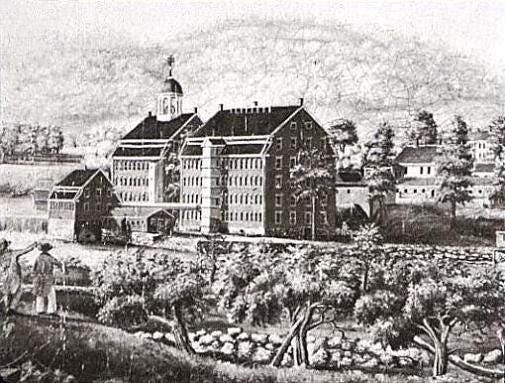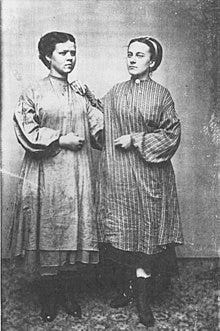What was the Lowell System?
From Francis Cabot Lowell’s power looms to America’s first factory town
By Charlotte Moy
The Lowell System, also known as the Waltham-Lowell system, was a vertically integrated system of textile production used in nineteenth-century New England. The Lowell system was an early form of the factory system, characterized by centralization, mechanization, new types of worker organization, and extensive division of labor.
Francis Cabot Lowell (1775-1817) first used the system in his textile mill in Waltham, Massachusetts, and some scholars credit his approach with bringing the modern factory to the United States. Lowell built on the advances made in the British textile industry, such as the use of the power loom, to industrialize American textile production.
He was the first factory owner in the United States to create a textile mill that was vertically integrated. Lowell also set his factory apart from others of the time by treating his workers fairly and creating a healthy physical and moral work environment for them. Lowell’s factory became famous during his lifetime and his methods were used in other textile mills after his death.
The Industrial Revolution and Rise of the Textile Industry
The Industrial Revolution began in England in the late eighteenth century and gradually spread to the United States and other European countries. Scholars associate it most fundamentally with the introduction of industrial technology into various types of manufacturing. But it also involved using mineral sources of energy, placing many workers in a factory setting, and advancing transportation methods.
Introducing technology into production allowed England, and eventually other countries, to increase production while lowering costs. This led to higher profits as well as an intense concern with protecting newly developed technology. As a result, England prohibited the export of new technologies to the United States. But as England flooded the United States with manufactured goods, Americans were inspired by England’s industrial success and became determined to imitate it.
Some of the most crucial machinery to the revolutions in both England and the United States consisted of devices used in the textile industry. Before the Industrial Revolution, the textile industry in England had predominantly revolved around wool, which workers spun into yarn on spinning wheels, then wove into cloth on hand looms. In the early eighteenth century, cotton became popular because it was more comfortable. Spinners could no longer keep up with the demand.
In response, James Hargreaves invented “the spinning jenny,” so that spinners could produce cotton yarn more quickly. The jenny was eventually expanded into a machine called “the mule,” which could produce cotton yarn 300 times faster than a spinning wheel. Less than a decade later, the weavers increased their production time due to the invention of the power loom. The collective influence of these devices on textile production meant that in 1850 Britain produced 200 times more cotton cloth than it had in 1780.
The United States also saw a significant increase in textile production at the very beginning of the nineteenth century. The number of cotton mills grew from 4 in 1803 to 62 in 1809 and continued to climb in the years after. Initially, textile mills in the United States were using the Slater Mill system (also called the Rhode Island system), implemented by William Slater in the late eighteenth century.
These mills relied on the labor of poor immigrants and were not vertically integrated. Instead, each village would specialize in one part of the production process, such as spinning or weaving.
Francis Cabot Lowell and America’s First Factory
The development of the Lowell system revolved around the life of Francis Cabot Lowell. Lowell was from an established Massachusetts family: his father was a member of the Continental Congress and served as a judge. Lowell attended Phillips Academy and eventually graduated from Harvard.
While his siblings pursued careers devoted to politics and religion, Lowell was more business-minded, devoting himself to establishing a successful textile mill. Before setting his plans in motion, Lowell spent two years touring factories in England and Scotland to examine their methods and machinery.
After returning to the United States, he and some investors, known as “The Boston Associates,” organized the Boston Manufacturing Company. In 1814, the company opened a mill next to the Charles River in Waltham, Massachusetts. This is where Lowell developed and implemented a new approach to textile production.
The Waltham–Lowell Model
The power loom was a key aspect of industrializing textile production and therefore crucial to Lowell’s success. But scholars disagree about how Lowell developed a working power loom. Many economic historians claim that Lowell essentially stole the design from the factories he visited in the United Kingdom, where owners did not know he intended to copy their systems and machinery. But Chaim M. Rosenberg argues that rather than stealing a design, Lowell brought the original design into a new stage of development. In addition to the power loom, Lowell’s factory utilized a variety of other devices, such as a new spinning mechanism invented by Paul Moody.
Mechanizing textile production was not Lowell’s only, or even his most important, contribution to the textile industry. Under Lowell’s model, the entire process of producing finished cloth from raw fiber occurred in one place. Known as vertical integration, this approach guaranteed that outsiders could not impede the production process.
Vertical integration is still an important strategy that both large and small companies use today in order to reduce transaction costs, assure the supply of important materials, improve coordination of production stages, and reduce competition by making an industry more expensive to enter.
The Lowell Mill Girls
In Lowell’s case, vertical integration vastly increased the scale of production to the point that there were not enough typical local workers to hire at his mill. To solve the labor shortage, Lowell hired girls from nearby farming families, generally between the ages of 15 and 35. This strategy contrasted sharply with that of the Slater mill, where entire families (including children) would be hired to work in the mill together.
Lowell’s strategy for hiring local women and keeping them satisfied as employees was one of the distinct aspects of his system. But he actually had more than one motivation for his approach. In addition to needing labor, Lowell was concerned about the moral deprivation and social upheavals associated with the Industrial Revolution in Great Britain.
Critics of the Industrial Revolution in Britain often pointed to the living conditions of workers. The poet William Blake (1757-1827) even referred to factories as “satanic mills.” Particularly in the early days of the revolution in Britain, worker wages were declining and both living and working conditions were bad. The housing was crowded with insufficient sanitary facilities and poor drainage. This led to outbreaks of typhus and cholera. Factory masters would lock workers in during 14-hour workdays, six days a week.
Work was monotonous and sometimes dangerous. Occasionally these conditions led to violent action by workers. During the Luddite Rebellion, groups of hand weavers became convinced that power looms were responsible for their lower wages and increasing unemployment. So, they organized themselves into groups and set out at night in disguises to smash the machines.
Although such reactions to industrial change were not the norm, Lowell was concerned and wished to avoid any similar chaos in his factory. Indeed, he wanted to make arrangements that encouraged the physical well-being and moral character of his workers. He recruited healthy and well-educated young women from farming families.
Although they worked long hours, these women received food and board and Lowell paid them in cash. The company hired women considered respectable as chaperones, required the workers to attend religious services, and provided opportunities for them to educate themselves.
These living arrangements made it easier to convince daughters from respected farming families to come to the mill to live and work temporarily. They would work hard at the mill for a year or more and save up what they earned until it was time to marry or return to their family’s farm. Lowell’s treatment of his workers earned respect from unexpected people. Charles Dickens, a harsh critic of British factories, wrote that Lowell’s employees were clean and healthy.
Why the Lowell System Reshaped American Industry
Lowell was not the only entrepreneur to bring the production of textiles to the United States. But he was the first to do so with a vertically integrated system, thus introducing the modern factory to the United States. Within its first few years of opening, Lowell’s factory produced nearly thirty miles of cloth each day.
President James Monroe visited Lowell’s factory as part of a tour of the northern and eastern states in 1817. Henry Clay also visited the factory in 1820 and praised its accomplishments in a speech to the House of Representatives.
The rise and fall of textile production in the United States is partially associated with the country’s relationship with Great Britain. During the War of 1812 (1812-1815), a large number of businessmen invested in manufacturing textiles.
After the war ended, Britain flooded the United States with cloth, sometimes even taking a loss in order to damage the American textile manufacturing business. Lowell argued in Washington for the government to take measures that would protect the growing textile industry. With the cooperation of William Lowndes and John C. Calhoun, he successfully advocated for the Tariff of 1816, a duty on cotton cloth.
Lowell died in 1817. Investors looking for a new spot for a textile mill established the city of Lowell, Massachusetts, named in honor of Francis Lowell. Eventually nicknamed “the city of spindles,” the city continued to grow the textile industry.
Unraveling the System
By the late nineteenth century, it had a population of almost 40,000, with the majority of working-age people employed in the textile industry. In the decades following Lowell’s death, industrial towns with mills that used the Lowell system were established throughout New England.
Although the factory system became a permanent part of production in the United States, Lowell’s version of it eventually lost favor. Initially, his system continued to find success but by the mid-nineteenth century it began to decline. Cotton overproduction lowered the price of finished cloth. In addition, more factory owners chose to use immigrant labor rather than following Lowell’s approach of hiring “mill girls.” Over time, New England’s textile mills looked less like Lowell’s Utopian system.
Sources
“Biographical Sketch.” Francis Cabot Lowell (1775-1817) Papers: Guide to the Collection. Massachusetts Historical Society Collection Guides.
“Factory System” in The Oxford Encyclopedia of Economic History. Edited by Joel Mokyr. Oxford University Press, 2003. p. 247-253.
Elvira, Andres. “Waltham-Lowell Textile System.” In Technical Innovation in American History: An Encyclopedia of Science and Technology, edited by Peg A. Lamphier and Rosanne Welch. Vol. 1, Colonial America to 1865. Santa Barbara: ABC-CLIO, 2019.
Jeremy, David I. "Damming the Flood: British Government Efforts to Check the Outflow of Technicians and Machinery, 1780-1843." The Business History Review 51, no. 1 (1977): 1-34.
Levack, Brian, Edward Muir, and Meredith Veldman. The West: Encounters and Transformations. Upper Saddle River, NJ: Pearson Education Incorporated, 2014.
Reese, Ty M. “Industrial Revolution (1780s-1840s).” The American Economy: A Historical Encyclopedia, edited by Cynthia L. Clark. Vol. 2, Essays and Primary Source Documents. Santa Barbara: ABC-CLIO, 2011.
Rosenberg, Chaim M. The Life and Times of Francis Cabot Lowell, 1775-1817. Lanham, Maryland: Lexington Books, 2010.
Wren, Daniel A. and Arthur G. Bedeian. The Evolution of Management Thought. Wiley, 2020.
Further Reading
“‘Father of the Whole Enterprise’: Charles S. Storrow and the Making of Lawrence, Massachusetts, 1845-1860.” History Cooperative.
Dalzell, Jr., Robert F. Enterprising Elite: The Boston Associates and the World They Made. Cambridge: Harvard University Press, 1987.
Dublin, Thomas. "Lowell Millhands" in Transforming Women's Work: New England Lives in the Industrial Revolution (1994) pp 77–118.
MacDonald, Allan. "Lowell: A Commercial Utopia". The New England Quarterly 10, no. 1 (1937): 37-62.


